The Affective Domain - PowerPoint PPT Presentation
1 / 11
Title:
The Affective Domain
Description:
q Relates to feelings about ourselves, the people around us, and the world we ... Kate and her classmates was to develop a 'personal trophy' using 3D materials. ... – PowerPoint PPT presentation
Number of Views:46
Avg rating:3.0/5.0
Title: The Affective Domain
1
The Affective Domain
2
- q Relates to feelings about ourselves,
the people around us, and the world we live in
including our relationship to other living
things. - q Development of self-esteem, empathy,
imagination and creativity. - q Multiple intelligences intra personal,
interpersonal, naturalistic. - q Recognised in CFS and VELS
- q Links to SOSE, Health.
3
Development of the affective domain
Offers children tools for personal growth, self
control, goal setting, imagination etc, that
will, with practice, become second nature.
4
- Tools for Affective learning
- Sensory engagement (sensing, trusting,
exploration, curiosity) - Quiet or guided techniques (centering, guided
imagery, listening) - Creative engagement (imagining, empathising,
trusting, exploring, being curious, emoting,
identifying) - Cultivating wonder(noticing, imagining,
dreaming, valuing, hoping)
5
Art Education is also a way of convincing
children that their actions, thoughts and
feelings really matter. Other people react
immediately to art we and our surroundings are
different because of it. These realizations
impart a sense of power. That sense is a critical
factor for learning and achievement because it
underlies feelings of responsibility. Art is
also a way to develop imagination and vision
about the future. Elaine Pear Cohen/Ruth
Straus Gainer Art Another language for Learning
3rd ed. P 2.
6
Response to the Foot and Mouth outbreak in the
UK Milburn Primary School, Cumbria, UK. Square
Sheep and Mudlarks Age range 8 - 11 Source
http//www.artworks.org.uk/galleries/project.asp?i
d104y2002i14
7
If the cognitive domain focuses on aspects of
knowing through our intellect, the affective
domain focuses our awareness on our hearts The
intent of including the affective domain is not
to assert its primacy over cognition or to
erect a wall between cognition and affect. It is,
rather, a way of legitimizing the ways in which
we learn about our beliefs, attitudes, feelings,
and concerns to facilitate a harmony between
affect and cognition. Edwards, L. (2002)The
Creative Arts A Process Approach for Teachers
and Children. Upper Saddle River, New Jersey
Merrill Prentice-Hall. p. 59.
8
Kate (2001) Do You Want Some Ice-cream Dad?
Mixed media (American artist - Grade 7 student
at Blake School)
9
This sculpture is about my dad. He died on June
6, 2000 at age 49 of cancer
Unfortunately Kates work is no longer on the
Blake School website, but it is still an
interesting site to visit. The design brief for
Kate and her classmates was to develop a
personal trophy using 3D materials. The work of
American artist Judy Orofino was used as a
discussion point. (links to Blake School and
Judy Orofino from my homepage)
10
Safe guardsSome students may find it confronting
to consider emotions for any number of
reasons. Emphasise safe space Have
counselling backup for studentsNotice students
who are struggling/talk quietlyNot a reason for
avoiding affective learning
11
- Your emotions into artmaking
- Affective learning
- Your feelings activated by experiencing the world
- CFS/VELS
- Your responses to artworks































